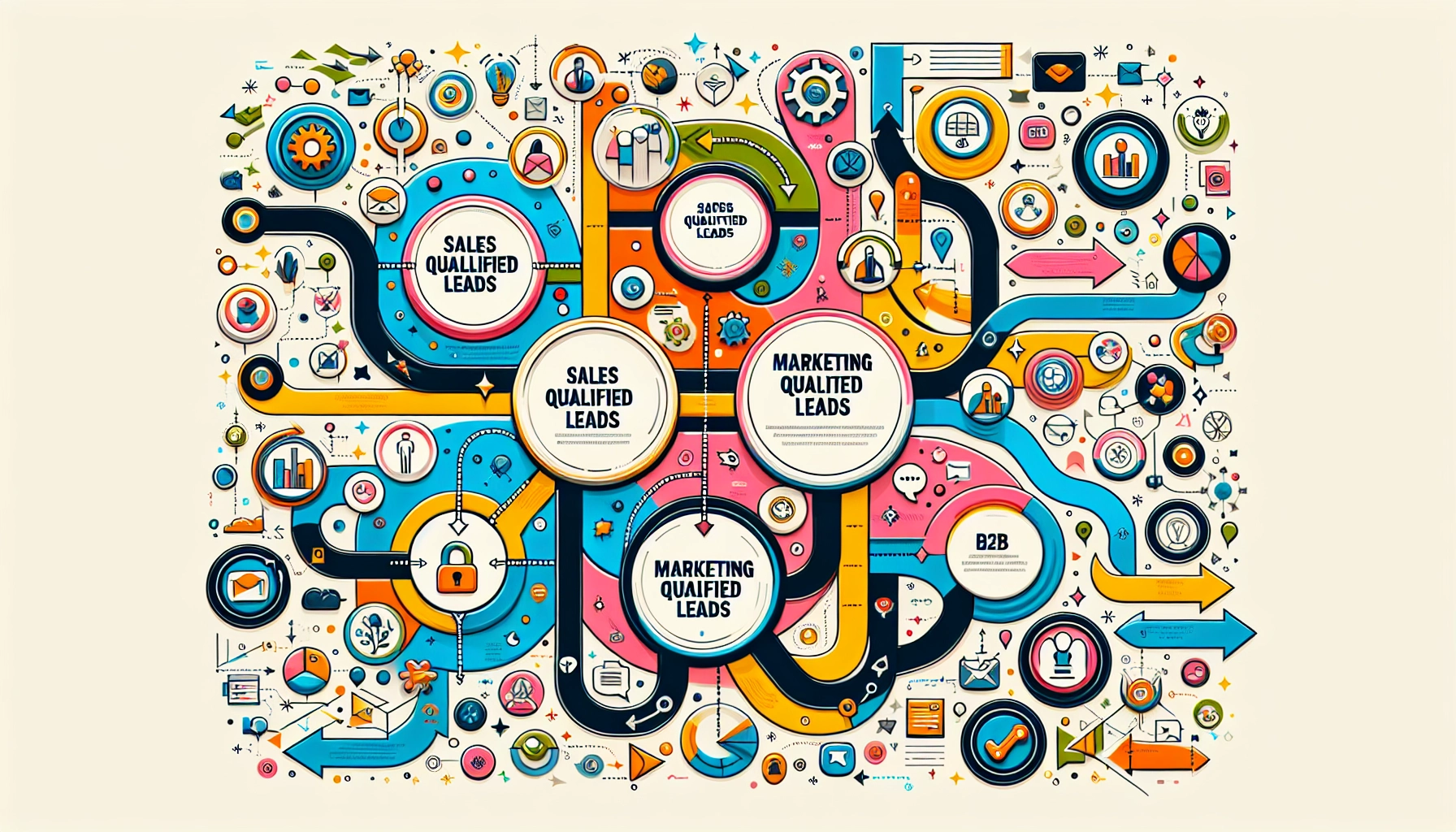Table of Contents[Hide][Show]
- Key Takeaways
- Types of B2B Leads
- The Role of Sales and Marketing Teams in Lead Generation
- Identifying Your Ideal Customer Profile
- Optimizing Landing Pages for Lead Capture
- Utilizing Social Selling Techniques
- Implementing Marketing Automation
- Using Paid Ads and Remarketing
- Using Trade Shows and Events for Lead Generation
- Measuring and Analyzing Lead Generation Efforts
- Summary
Want to improve your B2B lead generation? This article covers 10 practical and effective strategies to help you identify and attract potential clients. Implementing these strategies can enhance your marketing efforts and drive business growth.
Key Takeaways
- B2B lead generation is essential for driving sales and growth; focusing on targeted strategies yields better ROI.
- Understanding and nurturing different types of leads—MQLs, SQLs, and HQLs—can vastly improve your conversion rates.
- Collaboration between sales and marketing teams and effective use of content marketing and automation enhances lead generation effectiveness.
Understanding B2B Lead Generation

B2B lead generation is the process of finding and attracting people who are interested in what you offer. It’s a key part of sales and marketing, increasing sales conversions and growth. A structured lead generation process keeps you competitive and ensures a steady stream of high-quality leads.
Lead generation activities bring in new leads and guide existing leads to purchase decisions. This, in turn, drives sales growth and overall business performance. Targeted B2B lead generation usually gives a better return on investment than broader marketing as it’s focused on specific customer needs and wants to generate leads.
A solid lead generation strategy that gets into customer needs, behaviors, and wants means you can market more effectively. Your marketing will be more relevant and resonate with potential customers, leading to higher conversion rates and sales growth.
Definition and Importance of B2B Lead Generation
B2B lead generation is the process of identifying and converting potential customers into paying customers. It is a crucial step in a typical marketing strategy, marketing funnel, or sales process. High-quality B2B lead generation data is fundamental to analytics and forecasting. Accurate and complete contact details are crucial for sales reps to cold call or send outbound emails. Demand-generation marketers need precise data on target accounts to create and promote valuable content that converts.
In essence, lead generation is the lifeblood of any B2B business. Without a steady stream of high-quality leads, sales teams struggle to meet their targets, and business growth stalls. Companies can ensure a more efficient and effective sales process by focusing on generating leads that are more likely to convert into paying customers. This boosts revenue and enhances the overall customer experience, as sales reps can tailor their approach based on accurate and detailed information.
Brief Overview of the B2B Lead Generation Process
The B2B lead generation process involves several steps, including finding high-quality leads, reaching out to them through various marketing measures, qualifying and prospecting leads, and closing deals. Sales and marketing teams work closely together to achieve effective B2B lead generation. The process begins with identifying the target audience and creating content that resonates with them. This content is then distributed through various channels, such as social media, email marketing, and content marketing. The goal is to generate leads and convert them into paying customers.
A successful lead generation strategy requires a deep understanding of the target audience’s needs and pain points. Companies can attract potential leads and guide them through the sales funnel by creating valuable content that addresses these issues. Collaboration between sales and marketing teams is essential to ensure that leads are nurtured effectively and that the handover from marketing to sales is seamless. This integrated approach generates more leads and improves the quality of those leads, leading to higher conversion rates and increased sales.
Types of B2B Leads

B2B leads are people or organizations that can buy your products or services. B2B leads are more complex to qualify and convert than B2C leads because of the more complicated decision-making process. Knowing the different types of B2B leads is key to creating a lead generation strategy.
Marketing Qualified Leads (MQLs) are leads that have shown interest in your products or services but have not yet been fully qualified to engage with sales. They’ve engaged with your marketing, e.g., downloaded content or signed up for a newsletter.
On the other hand, Sales Qualified Leads (SQLs) show immediate interest in buying your products and are ready to be passed to the sales team for further conversation.
High-qualified leads (HQLs) are more likely to convert into paying customers because of their high interest and engagement with your offerings. You’ll get more sales leads and higher conversion rates by effectively targeting and nurturing each type of lead in your lead generation efforts.
The Role of Sales and Marketing Teams in Lead Generation
The sales and marketing teams need to work together to generate leads. When they do, they can increase customer retention and sales win rates. Aligning sales and marketing strategies helps to streamline the lead nurturing process, reduce the sales cycle, and ensure a smooth handover of leads through the sales funnel.
To collaborate better, sales and marketing teams should:
Define common language and metrics so they are speaking the same language.
Create roles within these teams to improve the lead generation process.
Use integrated tools for lead gen and CRM to coordinate and have visibility so both teams can work towards the same goal.
Marketing automation with CRM gives you a 360 view of customer behavior and interests so you can personalize and nurture. Aligning marketing to sales strategies means you can generate and nurture high-quality leads throughout the buying process and drive sales growth.
Identifying Your Ideal Customer Profile
Defining your ideal customer is key to generating leads. A buyer persona of your ideal customer is essential to tailor your marketing and ensure it resonates with your target audience. Several attributes like job title, pain points, and decision-making authority impact your ideal B2B sales lead’s buying behavior.
Building accurate buyer personas requires asking detailed questions about demographics, goals, and communication preferences. Generating B2B leads is all about defining your target audience and understanding the customer journey. Tailoring your lead generation to your business, industry, product/service, and audience will result in better marketing campaigns and higher conversion rates.
You may need multiple buyer personas as different products or services are for other buyers. Use tools like Dealfront Target to make sure your lead generation efforts target companies that match your ideal customer profile and get better marketing and more leads.
Effective B2B Lead Generation Strategies for 2025

As we advance through 2025, we need to adapt and implement B2B lead generation strategies that are relevant to today’s trends and technologies. Cater for buyers at different stages of the buying journey – awareness, evaluation, and purchase – and you will enhance your lead generation efforts. This section will look at specific strategies to help you generate and nurture high-quality leads.
From content marketing to whitepapers and case studies to webinars, these strategies have proven to work to attract and convert potential leads. By incorporating these into your lead generation efforts, you will be ahead of the competition and drive more sales.
Content Marketing
Content marketing is now the top source of leads for B2B. Evergreen content that remains relevant and valuable over time continues to attract leads long after it’s published. Using SEO and optimizing with relevant keywords can drive more traffic to your website and capture sales leads.
Writing lead-generating blog posts with valuable content like checklists, infographics, and other downloads can boost your content marketing. Posting content on social media can increase company awareness and attract leads by positioning you as an expert in your industry. Offering lead magnets – valuable content in exchange for contact info – can also capture leads.
Video is key to visibility and engagement, so it’s a must-have in your B2B content marketing. These content marketing tactics allow sales and marketing teams to generate and nurture high-quality leads and drive more sales and growth.
Leveraging Whitepapers and Case Studies
Whitepapers are great for thought leadership and attracting people interested in a specific topic. They are a key part of lead generation, and they provide in-depth info and insights to your target audience.
On the other hand, case studies show concrete proof of how your product solves a specific problem, so they are super valuable to risk-averse B2B buyers. Case studies show how your product or service can solve pain points and provide tangible benefits, so build trust and credibility with potential customers.
You need to promote case studies to get the most out of them. They shouldn’t sit on your website gathering dust; they should be distributed through multiple channels to get to a broader audience and more leads.
Whitepapers and case studies get you high-quality leads and guide them through the sales funnel, resulting in more sales and growth.
Hosting Webinars
Webinars are a great way to generate leads by talking to your audience about topics that matter to them. You can showcase your products to multiple people, highlight the benefits, and answer questions, which will lead to higher conversion rates. Webinars are more convenient than traditional online demos, so you get higher participation rates.
Webinars allow you to engage with customers, educate them about your offerings, build trust, and attract new leads. Including special offers in webinars will generate more leads by encouraging prospects to participate.
Webinars also help brand awareness by talking to potential clients before buying. Hosting webinars regularly allows you to engage with potential customers, address their pain points, showcase your products, and drive high-quality leads and conversion rates.
Search Engine Optimization (SEO) for Lead Generation
SEO is a crucial aspect of B2B lead generation. It involves optimizing a company’s website and online content to rank higher in search engine results pages (SERPs). This increases the visibility of the company’s website and attracts more qualified leads. SEO strategies include keyword research, on-page optimization, link building, and content creation. By optimizing their website for SEO, companies can increase their online presence, drive more traffic to their website, and generate more leads.
Effective SEO starts with thorough keyword research to identify the terms and phrases that potential leads are searching for. By incorporating these keywords into website content, meta descriptions, and headers, companies can improve their search engine rankings. On-page optimization, such as improving page load speed and mobile responsiveness, is critical in enhancing user experience and boosting SEO performance. Building high-quality backlinks from reputable websites can further increase a site’s authority and visibility. By investing in SEO, companies can attract a steady stream of qualified leads and drive long-term growth.
Pay-Per-Click (PPC) Advertising for Lead Generation
PPC advertising is another effective way to generate leads. It involves creating and publishing online ads that are paid for each time a user clicks on them. PPC ads can be targeted to specific keywords, demographics, and interests, making them a great way to reach a company’s target audience. By using PPC advertising, companies can drive more traffic to their website, increase brand awareness, and generate more leads.
One of the key advantages of PPC advertising is its ability to deliver immediate results. Unlike SEO, which can take time to build momentum, PPC ads can start driving traffic and generating leads as soon as they go live. By targeting specific keywords and demographics, companies can ensure that their ads are seen by the right people at the right time. This precision targeting increases the chances of converting clicks into leads and maximizes the return on investment. Additionally, PPC campaigns can be easily adjusted and optimized based on performance data, allowing companies to continually refine their approach and achieve better results.
Optimizing Landing Pages for Lead Capture

Landing pages are key to lead capture. Companies can see a significant increase in leads by having more landing pages and ensuring each is conversion-optimized. Clear and concise messaging about the offer is key to getting visitors engaged and taking action.
Videos, headlines, clear CTAs, and big font stats can grab attention and increase engagement. Personalized CTAs and solutions that match the visitor’s search can increase sales leads. Minimal navigation on landing pages helps to focus the visitor on the desired action, whether that’s filling out a form or signing up for a newsletter.
Contact pop-ups and sending social media traffic to specific landing pages for email signups can increase lead capture. Optimized landing pages capture more leads and more sales.
Utilizing Social Selling Techniques
Social selling on LinkedIn is working as a treat for B2B lead generation. You can connect and engage with potential customers and build relationships that lead to sales. Creating a personal brand on LinkedIn makes you more visible and positions you as an expert in your industry.
Getting introduced through mutual connections can have a significant impact on B2B decision-making and open up new doors. Sharing original content regularly positions you as an expert and attracts leads. Using LinkedIn’s Advanced Search helps you find potential clients based on specific criteria so you can target your outreach.
LinkedIn’s Social Selling Index (SSI) measures your brand and connection building. Using social selling gets you high-quality leads and more sales and growth.
Implementing Marketing Automation
Marketing automation can supercharge your lead generation. Marketing automation tools help with communication and follow-up with leads, and conversion rates go up. Lead scoring, which scores lead maturity, allows for more targeted sales efforts.
Customer segmentation allows you to send specific messages to specific segments, making communication more effective. CRM tools give you insights through lead scoring and customer segmentation, making it easier to nurture leads. Outbound automation software can send personalized emails at scale, and leads engage more.
Using Paid Ads and Remarketing

Paid ads and remarketing are great for generating leads in B2B. Google is the most popular search engine. Ads can be super profitable if you convert leads during your campaigns. B2B Google. Ads need to be targeted to the longer sales cycle in this space.
Using negative keywords helps B2B companies avoid unqualified clicks and increase conversion rates. Keep your Google account. Ads account organization helps with targeting and lead generation. Remarketing allows you to re-engage with users who visited your site but didn’t convert into leads, which is another chance to grab them.
Using Trade Shows and Events for Lead Generation
Trade shows and events are a great way to generate leads and connect with potential customers in person. They provide an opportunity for companies to showcase their products and services, build relationships with attendees, and collect contact information from interested individuals. To make the most of trade shows and events, companies should have a clear plan in place, including a lead generation strategy, a follow-up plan, and a way to measure the event’s success. By using trade shows and events effectively, companies can generate more leads, increase brand awareness, and drive more sales.
Participating in trade shows and events allows companies to engage with their target audience more personally and interactively. Companies can build trust and credibility with potential leads by demonstrating products, answering questions, and providing hands-on experiences. It’s essential to have a well-trained team on hand to capture contact information and follow up with attendees promptly. Post-event follow-up is crucial to converting leads into paying customers, so a structured plan is vital. By leveraging the power of trade shows and events, companies can expand their reach, generate high-quality leads, and boost their sales pipeline.
Measuring and Analyzing Lead Generation Efforts
Measuring and tracking your lead generation efforts is key to refining and improving. Conversion rate is how well you turn website visitors into customers, and it gives you insight into your marketing. Cost per Lead (CPL) is how efficient your lead generation efforts are.
Customer Acquisition Cost (CAC) is how much it costs to get a new customer, and lead-to-customer ratio is how well you convert leads into paying customers. A/B testing tools let you test, compare, and track metrics like engagement.
Marketing automation can give you more sales productivity, more qualified leads, and more sales and business growth. Measuring and tracking your lead generation efforts lets you refine and win.
Summary
To generate successful B2B leads, it’s vital to grasp the intricacies of your ideal customer profile and foster a synergistic relationship between sales and marketing teams. Employing an array of tactics is crucial for producing high-quality prospects—be it through content marketing by using whitepapers and case studies or by conducting webinars and refining landing pages. Each approach is essential in attracting and converting potential leads.
As we navigate 2025, staying current with emerging trends and technology advancements will be imperative to outpace competitors. Incorporating marketing automation tools, embracing social selling techniques, and proficiently utilizing paid ads alongside retargeting strategies can significantly amplify your lead generation campaigns. Constant evaluation and meticulous analytics assessment allow you to incrementally perfect your methods for more effective outcomes.
The cornerstone for fruitful lead generation hinges on deeply knowing who constitutes an ideal customer, orchestrating harmonized initiatives within sales and marketing realms, and deploying diverse approaches that draw in and transform prospective clients into actual customers. Adhering to these established norms empowers businesses to escalate their revenue and ensure enduring progression.
Frequently Asked Questions
What is the difference between Marketing Qualified Leads (MQLs) and Sales Qualified Leads (SQLs)?
Content marketing is a powerful tool for B2B lead generation as it engages your audience with valuable content that meets their needs. You can effectively attract and nurture potential leads by delivering relevant information through blogs, videos, and infographics.
Why is it essential to optimize landing pages for lead capture?
Enhancing the clarity and engagement of landing pages for lead capture is vital, as it encourages visitors to engage by completing actions such as form submissions.
How does marketing automation improve lead-generation efforts?
Marketing automation supercharges your lead generation by ensuring timely follow-ups and personalized communication while automating tedious tasks that boost your sales productivity.
What role do webinars play in B2B lead generation?
Hosting informative webinars is instrumental in generating B2B leads, as they captivate potential customers and establish trust while demonstrating your expertise. These sessions serve as an effective means to educate prospects and cultivate high-quality leads for lead-generation efforts.
 Strategies for Effective Brand Marketing in 2025
Strategies for Effective Brand Marketing in 2025